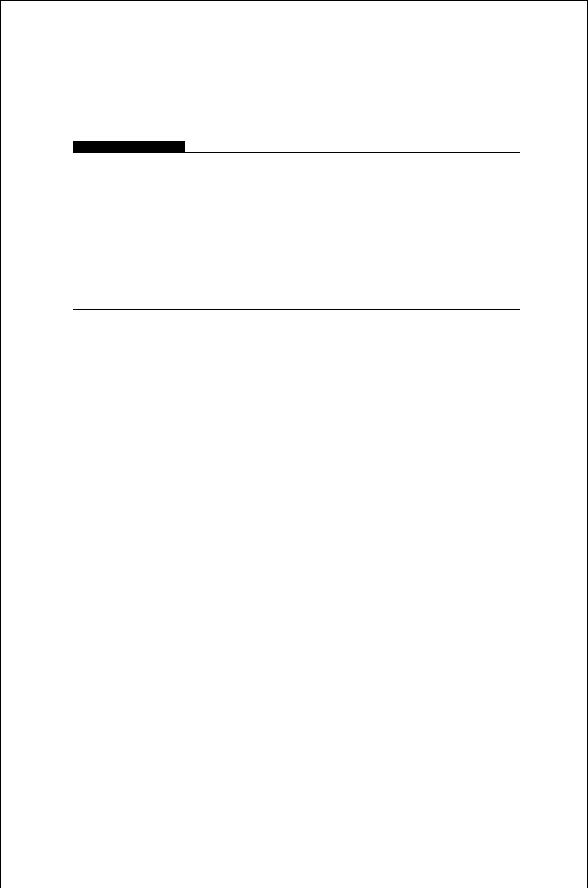
Davis W.A.Radio frequency circuit design.2001
.pdf
Preface
The cellular telephone has become a symbol for the rapid change in the communications business. Within this plastic container reside the talents of engineers working in the areas of efficient power supplies, digital circuit design, analog circuit design, semiconductor device design, antennas, linear systems, digital signal processing, packaging, and materials science. All these talents are carefully coordinated at a cost that allows a wide cross section of the world’s population to have available instant communication. The particular aspect of all these activities that is of primary focus in this text is in the area of analog circuit design, with primary emphasis on radio frequency electronics. Some topics normally considered in electronics courses or in microwave and antenna courses are not covered here. For example, there is no mention of distributed branch line couplers, since at 1 GHz their size would be prohibitive. On the other hand, topics such as transmission line transformers are covered because they fit so well into this frequency range.
This book is meant for readers who have at least advanced standing in electrical engineering. The material in this text has been taught as a senior and graduate-level course in radio frequency circuit design at the University of Texas at Arlington. This class has continued to be popular for the past 20 years under the guidance of at least four different instructors, two of whom are the present authors. Because of the activity in the communications area, there has been ever greater interest in this subject. It is the intent of the authors, therefore, to update the current text offerings while at the same time avoiding simply reworking a microwave text.
The authors gratefully acknowledge the contribution of Michael Black, Raytheon Systems Company, to the phase lock loop discussion in Chapter 12.
W. Alan Davis
Krishna Agarwal

Radio Frequency Circuit Design. W. Alan Davis, Krishna Agarwal
Copyright 2001 John Wiley & Sons, Inc.
Print ISBN 0-471-35052-4 Electronic ISBN 0-471-20068-9
CHAPTER ONE
Communication Channel
1.1BASIC TRANSMITTER–RECEIVER CONFIGURATION
The design of radio frequency (RF) circuits borrows from methods used in lowfrequency audio circuits as well as from methods used in design of microwave circuits. Yet there are also important departures from these techniques, so the design of radio frequency circuits requires some specialized techniques not found in these other frequency ranges. The radio frequency range for present purposes will be taken to be somewhere between 300 MHz and 3 GHz. It is this frequency range where much of the present day activity in wireless communication occurs. In this range of frequencies, the engineer must be concerned about radiation, stray coupling, and frequency response of circuit elements that from the point of view of lumped, low-frequency analysis might be expected to be independent of frequency. At the same time the use of common microwave circuit elements such as quarter wave transformers is impractical because of the long line lengths required. The use of monolithic circuits have enabled many highfrequency designs to be implemented with lumped elements, yet the frequency response of these “lumped” elements still must be carefully considered.
Today RF and digital designs have begun to move closer together, so typical communication systems incorporate both of these disciplines in their design. While direct digitizing of RF signals remains a challenge, there are many systems where digital signal processing is playing a larger role than ever in communication systems. A typical radio analog transmitter and receiver is shown in Fig. 1.1. In this system the information source could be an audio or video signal. This information in the process of being converted from, say, sound to an electrical signal by a transducer produces a very low voltage that must be amplified by an audio amplifier.
The modulator is shown schematically as a mixer that represents a wide variety of different modulation schemes. The two major categories are analog and digital modulation. In either case the modulator performs two functions. The first function is that it encodes the message in a certain way so as to meet the communication channel requirements for cost, noise immunity, fading, available
1

2
Information
Source
Low
Noise
Amp
Transducer
Audio
Amplifier
Multiplier
IF
Amplifier
+
–
Multiplier
Modulator
Power
Amplifier
+
Local  Oscillator –
Oscillator –
Demodulator |
|
Lowpass |
Audio |
Transducer |
|
Filter |
Amplifier |
||
|
|
|
||
|
|
|
|
|
FIGURE 1.1 Diagram of a communication transmitter and receiver.

INFORMATION AND CAPACITY |
3 |
bandwidth, bandwidth efficiency (the ratio of the throughput data rate per Hertz in a given bandwidth), power efficiency (which measures the ability of a system to preserve the message under low power conditions), and so on.
For the amplitude modulation (AM) case, the mixer is a multiplier that
multiples the information message with the |
local oscillator frequency. Just |
as the product of two sine waves produces |
sum and difference frequencies, |
so the message frequency is added to the local oscillator frequency. This produces two effects necessary for practical wireless communications. The first is that this enables forming multiple channels, which in the amplitude and frequency modulation (FM) analog systems are separated by different frequency bands. Otherwise, there would be massive interference between different signals. This method of separating signals is called frequency division multiple access (FDMA). Alternate methods are time division multiple access (TDMA) where two or more signals may share the same frequency band but use it at different times. The human receiver is able to integrate over the different time slots so that the message is perceived to be continuous. A third method is the spread spectrum technique known as code division multiple access (CDMA) where a broad bandwidth is used by multiple users continuously. However, each user sends and receives data that is coded in a particular way, different from all the other users. When there is interference between users, it is perceived as low-level noise.
The second function of the modulator is that it translates the message information to a much higher RF signal. For this reason antennas can be made a manageable size, with their mechanical size normally correspondings to the wavelength. A great deal of effort has gone into making smaller antennas, but there are always design compromises.
The final stage of the transmitter before reaching the antenna is the power amplifier. Since this component uses the greatest amount of power, high efficiency becomes an important factor. In FM systems, class C amplifiers are often used because, in practice, they can produce efficiencies as high as 70%. For AM systems, class A or AB amplifiers are often used because of the required linearity of AM signal transmission. However, class A amplifiers typically have efficiencies of 30% to 40%.
As for the receiver, the received signal is sometimes strong enough to be put directly into the mixer. However, as will be seen later (in Chapter 8), the overall noise response of the amplifier is greatly enhanced by using a low-noise amplifier for the front end. The demodulator in the receiver must correspond to the modulator in the transmitter. The subsequent intermediate frequency (IF) amplifier includes the required filtering to provide the desired selectivity for the received signal. The IF frequency is chosen to be sufficiently high to avoid most of the 1/f noise (f D frequency) or flicker noise. Since this circuit operates at a fixed frequency, it can be carefully tuned for optimum performance.
1.2INFORMATION AND CAPACITY
RF communication systems provide a means of carrying information from the transmitter to the receiver. Now, what exactly is information? Webster’s

4 COMMUNICATION CHANNEL
Dictionary states that “information” is “knowledge communicated or received concerning a particular fact or circumstance. . ..” A narrower, technical definition that more closely aligns with our focus that “information” is an “indication of the number of possible choices of messages, which are expressible as the value of some monotonic function of the number of choices, usually log to the base 2.” “Information” then is a term for data that can be coded for digital processing.
Some examples of data that illustrate the meaning of information is helpful. If a signal were sent through a communication channel that never changed, then it would be conveying no information. There must be change to convey a message. If the signal consisted of 1 0 1 0 1 0 1 0. . . , there would be changes in the signal but still no information is conveyed, because the next bit would be perfectly predictable. So while change is important, it is not the sole criterion for information. There is one last example. If a signal in an amplitude modulation system consists of purely random voltage fluctuations, then again no information can be transmitted. It is simply noise, and the receiver becomes no more knowledgeable upon having heard it.
A communication system consists of a transmitter, a receiver, and a channel. The channel is capable of carrying only a certain limited amount of information. Roughly analogous to an information channel is a water pipe which, because of its diameter, is restricted to carrying only a certain amount of water. This limitation is given the technical term “capacity.” It refers to the amount of information that is transmitted over a time interval of T seconds. The time interval can be broken up into shorter time intervals, each of duration . Clearly, the more distinct time intervals these are in the total time span T, the more information can be transmitted. The minimum size of is determined by how well one pulse in one time frame can be distinguished from a pulse in a neighboring time frame. The limitation on how short a time frame can be is related to the channel bandwidth.
In addition the signal voltage will have a maximum amplitude that is limited by the available power in the system. This voltage range can be divided into many levels, each level representing a bit of information that is distinguished from another bit. The voltage range cannot be infinitely split because of the noise that is always present in the system. Clearly, the more voltage intervals there are in a given time frame , the more information capacity there is in the system. Just as the flow of water through a pipe is limited by the amount of pressure on the water, by the friction on the walls of the pipe, and by the diameter of the pipe, so the capacity of a transmission system is limited by the maximum voltage level, by the noise in the system that tends to muddle the distinction between one voltage level and another, and by the bandwidth of the channel, which is related to the rise time of a pulse in the system.
In one of the time intervals, , there are n voltage levels. The smaller that is and the larger that n is, the more information there can be transmitted through the channel. In each time interval there are n possible voltage levels. In the next time interval there are also n possible voltage levels. It is assumed that the voltage

INFORMATION AND CAPACITY |
5 |
level in each time frame is independent of what is going on in other time frames. The amount of information transmitted in a total of T seconds corresponds to the product of the possible levels in each interval:
n Ð n Ð n Ð n . . . nT/ |
1.1 |
The total information transmitted intuitively is directly proportional to the total time span T, which is defined as the log of the above product. By convention, the base-2 logarithm is used.
T |
1.2 |
H D log2 n |
The system’s capacity is simply the maximum rate of transmission (in bits/s) through a system:
H1
C D D log2 n 1.3
T
System capacity is inversely proportional to the minimum time interval over which a unit of information can be transmitted, . Furthermore, as the number of voltage levels increases, so does the capacity for more information.
Information can be transmitted through a channel in a variety of different forms, all producing the same amount of information. For example, suppose that a signal can take on any one of eight different voltage levels, 0, 1, . . . , 7, in a given time interval . But the eight signal levels could also equally be sent with just two levels, 0, 1. For every interval that has eight possible levels, three intervals will be needed for the two-level signal. A convenient conversion between the two systems is shown in Table 1.1.
Clearly, a 16-level signal could be transmitted by a sequence of four binary signals, and a 32-level signal with a sequence of five binary signals, and so on. For n levels, log2 n bits are needed. The information content of a signal is defined then to be the number of binary choices, or bits, that are needed
TABLE 1.1 Eight-Level and
Two-Level Systems
n D 8 |
n D 2 |
0 |
000 |
1 |
001 |
2 |
010 |
3 |
011 |
4 |
100 |
5 |
101 |
6 |
110 |
7 |
111 |
|
|

6 COMMUNICATION CHANNEL
for transmission. A system is designed to transmit speech must be designed to have the capacity to transmit the information contained in the speech. While speech is not entirely what humans communicate, in a communication system it is what engineers have to work with. A decision must be made as to with what fidelity the speech is to be transmitted. This translates to the bandwidth requirement of an analog system, or the number of voltage levels available in a given total voltage range. Ultimately this restriction is always present even if sophisticated coding techniques are used. The capacity of the system must be ½, the rate of information that is to be transmitted. Beyond this capacity, system cost, power levels, and available transmission media must be considered.
1.3DEPENDENT STATES
The definitions of the preceding section imply that the voltage level in each time interval, , is independent of the voltage level in other time intervals. However, one simple example where this is not the case is the transmission of the English language. It is known that in the English language the letter e appears more frequently than the letter z. It is almost certain that the letter q will be followed by the letter u. So, in transmitting a typical message in English, less information is actually sent than would be sent if every letter in the alphabet were equally likely to occur. A way to express this situation is in terms of probability. We are interested in the total number of signal combinations that could occur in a message T seconds long if each interval that is independent from the others is nT/ . On average, every possible message T seconds long would have a probability of occurrence of 1/nT/ .
The probability takes the form
number of occurrences of a particular event
P D |
|
1.4 |
|
||
|
total number of events |
|
For information measured in terms of probability, P D 1/n if there are n events specified as n voltage levels and each of these events is equally likely. For any one event, the information transmitted is written H1 D log2 P. For m intervals, each seconds long, there will be m times more information. So for m intervals, the information written in terms of probability is
T |
|
H D log2 n D m log2 P bits |
1.5 |
Consider a binary system where a number 0 occurs with probability p and the number 1 occurs with probability q. Knowing that p C q D 1, the information content of a message consisting of 0’s and 1’s is to be found. The total information is the sum of the information carried by the 0’s and that of the 1’s:

DEPENDENT STATES |
7 |
T
H D p Ð log2 p C q Ð log2 q bits 1.6
If the probabilities of p and q seconds is T/ . If, for example,
are each 0.5, then the total information in T p D 0.25 and q D 0.75, then
T
H D 0.25 Ð log2 0.25 C 0.75 Ð log2 0.75 bits
|
T |
|
T |
|
|
|
H D |
|
0.5 C 0.3113 |
D 0.8113 |
|
bits |
1.7 |
|
|
|||||
Hence, when there is a greater probability that an expected event will occur, there is less information. As p approaches 1 and q approaches 0, the near certainty of event with probability p will give 0 information. The maximum information occurs when p D q D 0.5.
This scenario can be generalized for n signal levels in a given signal interval. Assume that each of these n signal levels, si, has a probability of occurrence of Pi where
P1 C P2 C Ð Ð Ð C Pn D Pi D 1 |
1.8 |
Assume further that the probability of a finding a given signal level is independent of the value of the adjacent signal levels. The total information in T/ intervals or in T seconds is
H D |
T |
n |
Pi log2 Pi |
bits |
1.9 |
||
|
|
|
|||||
|
i |
||||||
The capacity required to transmit this amount of information is then |
|
||||||
1 |
|
n |
Pi log2 Pi |
bits/s |
1.10 |
||
C D |
|
|
|
||||
|
i |
||||||
In the case where each level is equally likely, P1 D P2 D P3 D Ð Ð Ð Pn D 1/n, then for the n level signal,
|
T |
n |
|
T |
|
|
H D |
|
|
Pi log2 Pi D |
|
log2 n bits |
1.11 |
|
i |
|
||||
More detail on information transmission can be found in specialized texts; a short introduction is given by Schwartz [1]. In general, this study of radio frequency design, the primary focus will be on fundamental hardware design used in transmitters and receivers. Other topics that are of great interest to communication engineers such as programming digital signal processing chips, modulation schemes, and electromagnetic propagation problems are more fully explored in

8 COMMUNICATION CHANNEL
specialized texts in those areas. In this book these areas will be referred to only as needed in illustrations of how systems can be implemented.
PROBLEMS
1.1A pulse train is being transmitted through a channel at the maximum channel capacity of 25 Ð 103 bits/s. The pulse train has 16 levels.
(a)What is the pulse width?
(b)The pulse width is doubled and sent back on the same channel. What is number of levels required?
REFERENCES
1.M. Schwartz, Information Transmission, Modulation, and Noise, 3rd ed., New York: McGraw-Hill, 1980, Ch. 1.

Radio Frequency Circuit Design. W. Alan Davis, Krishna Agarwal
Copyright 2001 John Wiley & Sons, Inc.
Print ISBN 0-471-35052-4 Electronic ISBN 0-471-20068-9
CHAPTER TWO
Resistors, Capacitors, and
Inductors
2.1INTRODUCTION
At radio frequencies passive circuit elements must be considered more carefully than in lower-frequency designs. The simple resistor, capacitor, or inductor cannot be counted on to provide pure resistance, capacitance, or inductance in high-frequency circuits. Usually the “lumped” element is best modeled as a combination of these pure elements. In addition, when the size of the element becomes larger than 0.1 wavelength in the circuit medium, the equivalent circuit should include the transmission lines.
2.2RESISTORS
Integrated circuit resistors can be classified into three groups: (1) semiconductor films, (2) deposited metal films, and (3) cermets (a mixture of metal and dielectric materials). Of these, only the first two have found widespread use in highfrequency circuits. Semiconductor films can be fabricated by diffusion into a host semi-insulating substrate, by depositing a polysilcon layer, or by ion implantation of impurities into a prescribed region. Polysilcon, or polycrystalline silicon, consists of many small submicron crystals of silicone with random orientations.
2.2.1Resistor Types
The resistance value of an integrated circuit resistor depends on the conductivity of the channel through which the current is flowing. In the diffused resistors in a semiconductor substrate, the conductivity is a function of the doping concentration
9
